【C语言】动态内存管理
为什么存在动态内存分配
到目前为止,我们已经掌握的内存开辟方式有两种:
- 创建变量:
int val = 20; //在栈空间上开辟四个字节
- 创建数组:
char arr[10] = {0}; //在栈空间上开辟10个字节的连续空间
上述的开辟空间的方式有两个特点:
- 空间开辟大小是固定的。
- 数组在申明的时候,必须指定数组的长度,它所需要的内存在编译时分配。
但是对于空间的需求,不仅仅是上述的情况。有时候我们需要的空间大小在程序运行的时候才能知道,那数组的编译时开辟空间的方式就不能满足了。
这两种内存开辟的方法创建的空间大小是固定的,不能发生变化,因此就存在一定的局限性。C语言为了让我们更加灵活容易的控制我们所需的内存空间的大小,提供了动态内存管理的功能,也相应地提供了一些动态内存管理的函数。那这篇博客将带着大家来认识这些函数。
动态内存函数的介绍
malloc 和 free
C语言提供了一个动态内存开辟的函数:

这个函数向内存申请一块连续可用的空间(字节),并返回指向这块空间的指针。
- 如果开辟成功,则返回一个指向开辟好空间的指针。
- 如果开辟失败,则返回一个NULL指针,因此malloc的返回值一定要做检查。
- 返回值的类型是 void* ,所以malloc函数并不知道开辟空间的类型,具体在使用的时候使用者自己来决定。
- 如果参数 size为0,malloc的行为是标准是未定义的,取决于编译器。
C语言提供了另外一个函数free,专门是用来做动态内存的释放和回收的:

free函数用来释放动态开辟的内存,参数是开辟内存的起始位置。
- 如果参数 ptr 指向的空间不是动态开辟的,那free函数的行为是未定义的。
- 如果参数 ptr 是NULL指针,则函数什么事都不做。
malloc 和 free 都声明在 stdlib.h 头文件中。
malloc 和 free 函数的基本使用:
申请20个字节的内存空间来存放整形
#define _CRT_SECURE_NO_WARNINGS
#include <stdio.h>
#include<stdlib.h>
int main()
{
int* p = (int*)malloc(20); // 由于要存储的为整形,使用int* 的指针来管理比较方便
// malloc的返回值为void*,想要将其赋给int* 的指针,必须进行强
// 制类型转化
// malloc 函数也是有可能开辟空间失败的,一般都会对malloc函数的返回值进行判断
if (p == NULL)
{
printf("%s\n", strerror(errno));
}
//使用
int i = 0;
for (i = 0; i < 5; i++)
{
*(p + i) = i + 1;
printf("%d ", *(p + i));
}
//需要对主动申请的空间需要进行主动释放
free(p);
//虽然已经释放了p指向的内存,但p还是指向地址没有发生变化,为了避免野指针,应该将p置空
p = NULL;
}

calloc
malloc函数在初始化时会将每个字节赋一个随机值:

因此C语言还提供了一个函数叫 calloc , calloc 函数也用来动态内存分配:

- 函数的功能是为 num 个大小为 size 的元素开辟一块空间,并且把空间的每个字节初始化为0。
- 与函数 malloc 的区别只在于 calloc 会在返回地址之前把申请的空间的每个字节初始化为全0。
calloc 函数的基本使用:
#define _CRT_SECURE_NO_WARNINGS
#include <stdio.h>
#include<stdlib.h>
#include<string.h>
int main()
{
int* p = (int*)calloc(10,sizeof(int)); // 开辟10个整形的空间
if (p == NULL)
{
printf("calloc() --> %s\n", strerror(errno));
}
//使用
int i = 0;
for (i = 0; i < 10; i++)
{
printf("%d ", *(p + i));
}
//释放
free(p);
p = NULL;
return 0;
}

calloc 和 malloc 函数的对比:
- 参数不同。
- 都是在堆区上申请内存空间,但是 malloc 不初始化,calloc 会初始化为0。如果需要初始化就用 calloc,不需要就用 malloc 。
- 由于 malloc 没有初始化,因此 malloc 效率会比 calloc高,因此在使用时需要进行决策判断用哪种效果更好。
realloc
- realloc函数的出现让动态内存管理更加灵活。
- 有时会我们发现过去申请的空间太小了,有时候我们又会觉得申请的空间过大了,那为了合理的时候内存,我们一定会对内存的大小做灵活的调整。那 realloc 函数就可以做到对动态开辟内存大小的调整。

- ptr 是要调整的内存地址。
- size 调整之后新大小。
- 返回值为调整之后的内存起始位置。
- 这个函数调整原内存空间大小的基础上,还会将原来内存中的数据移动到新的空间。
- realloc在调整内存空间的是存在两种情况:
情况1:原有空间之后有足够大的空间。
情况2:原有空间之后没有足够大的空间。

在实际使用realloc函数时可能会出现以下两种情况:
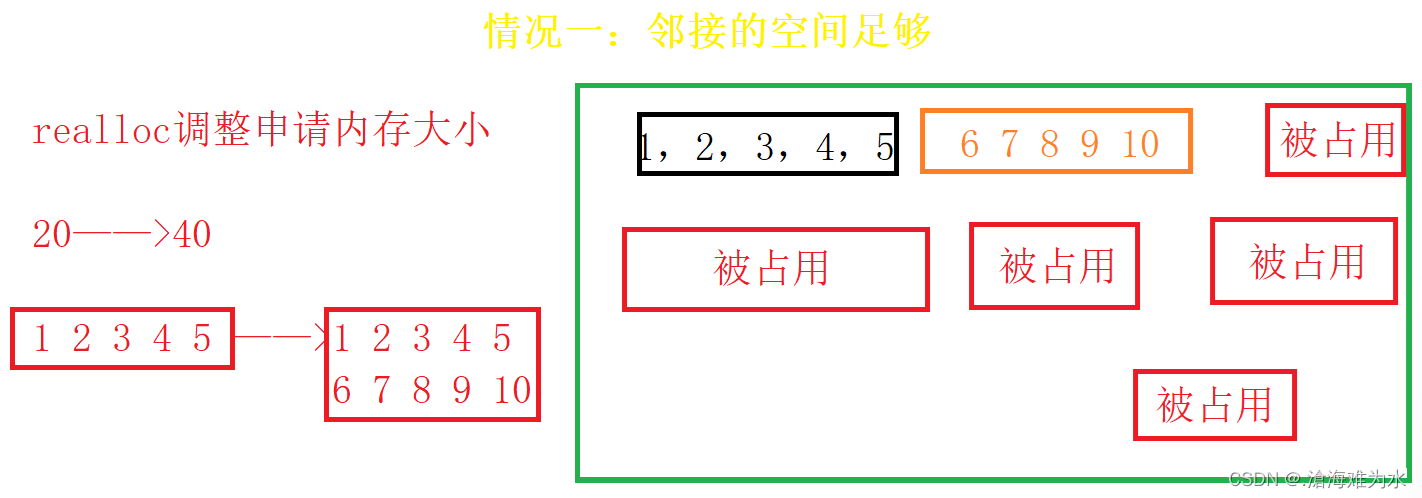
情况一:realloc 返回的是旧地址,要扩展内存就直接原有内存之后直接追加空间,原来空间的数据不发生变化。
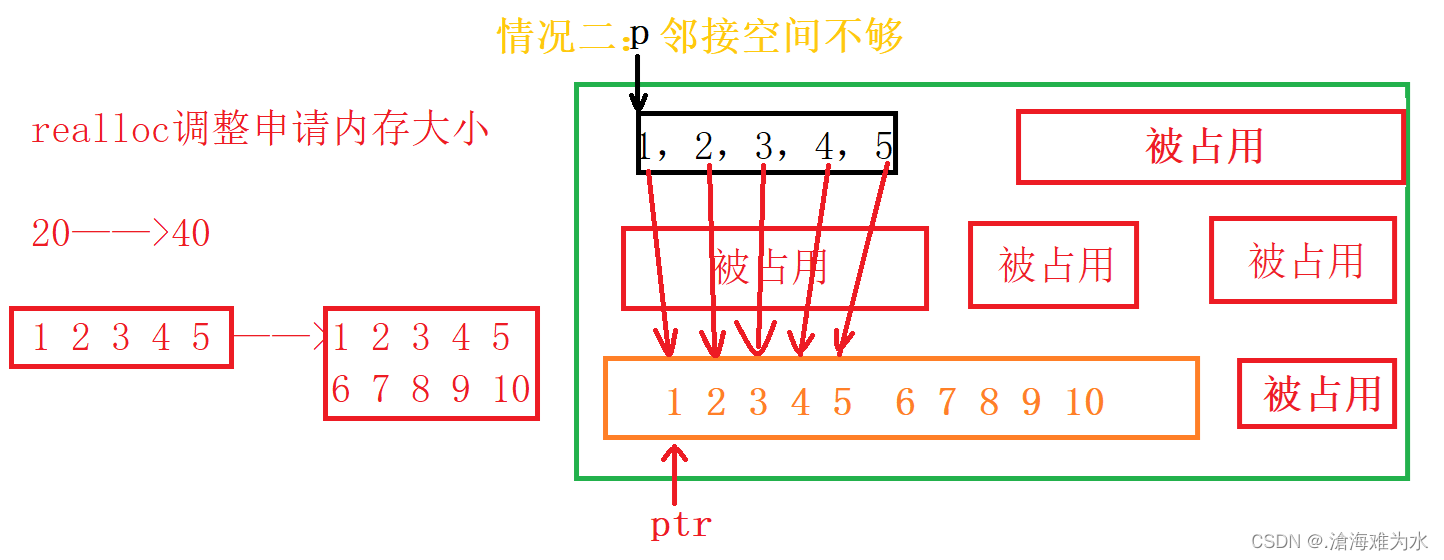
在遇到情况二时需要注意一些点:
- 在空间不足时,realloc 会寻找更大的空间。
- 将原来的数据拷贝到新的空间。
- 释放旧的空间。
- 返回新空间的地址。
原有空间之后没有足够多的空间时,扩展的方法是:在堆空间上另找一个合适大小的连续空间来使用,这样函数返回的是一个新的内存地址。
realloc 的基本使用:
#define _CRT_SECURE_NO_WARNINGS
#include <stdio.h>
#include<stdlib.h>
#include<string.h>
int main()
{
int* p = (int*)malloc(20);
if (p == NULL)
{
printf("%s\n", strerror(errno));
}
//使用
int i = 0;
for (i = 0; i < 5; i++)
{
*(p + i) = i + 1;
}
int* ptr = (int*)realloc(p, 40);
if (ptr != NULL)
{
p = ptr;
for (i = 5; i < 10; i++)
{
*(p + i) = i + 1;
}
for (i = 0; i < 10; i++)
{
printf("%d ", *(p + i));
}
}
else
{
printf("realloc --> %s\n", strerror(errno));
}
//释放
free(p);
p = NULL;
return 0;
}

常见的动态内存错误
对NULL指针的解引用操作
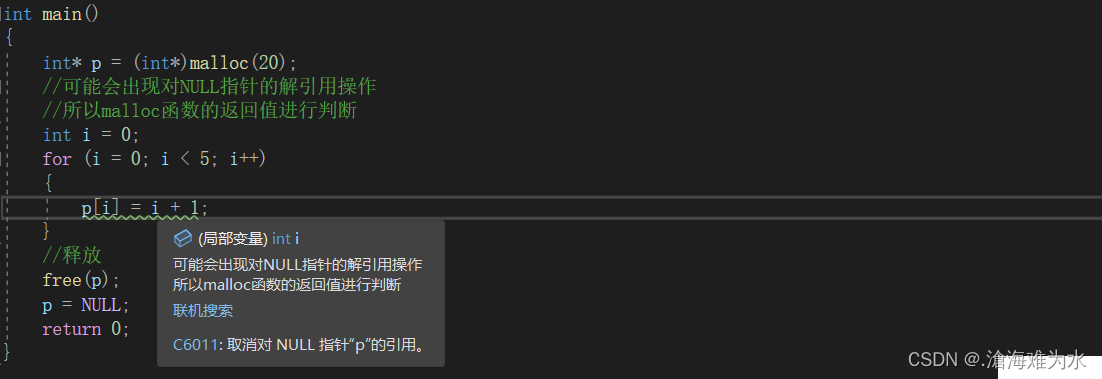
对动态开辟空间的越界访问
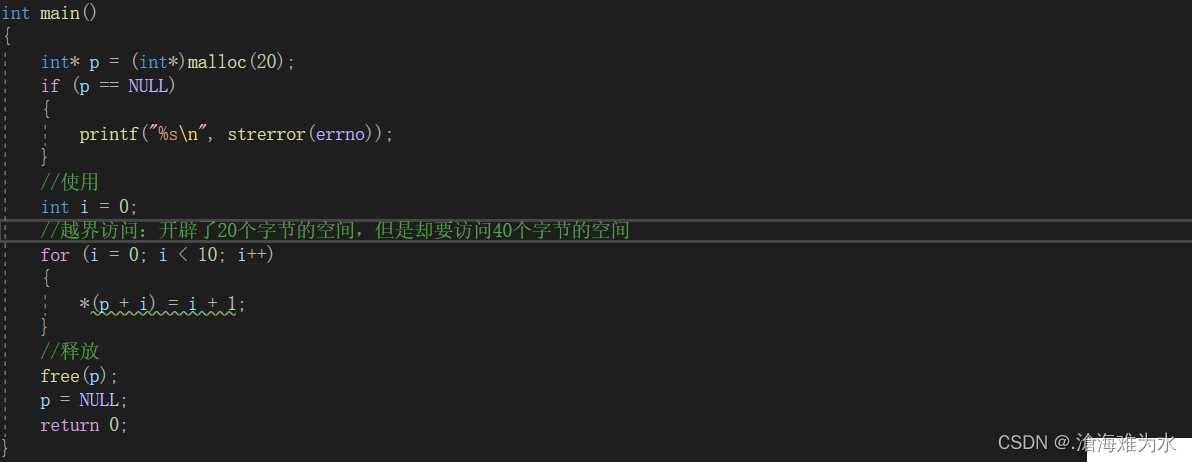
对非动态开辟内存使用free释放

使用free释放一块动态开辟内存的一部分
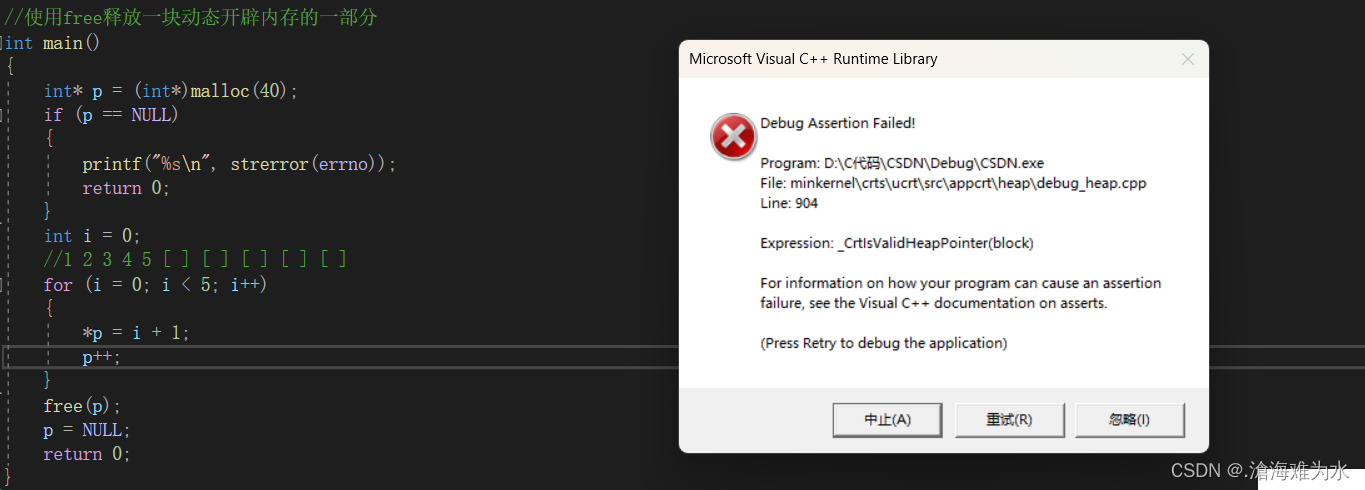
对同一块动态内存多次释放
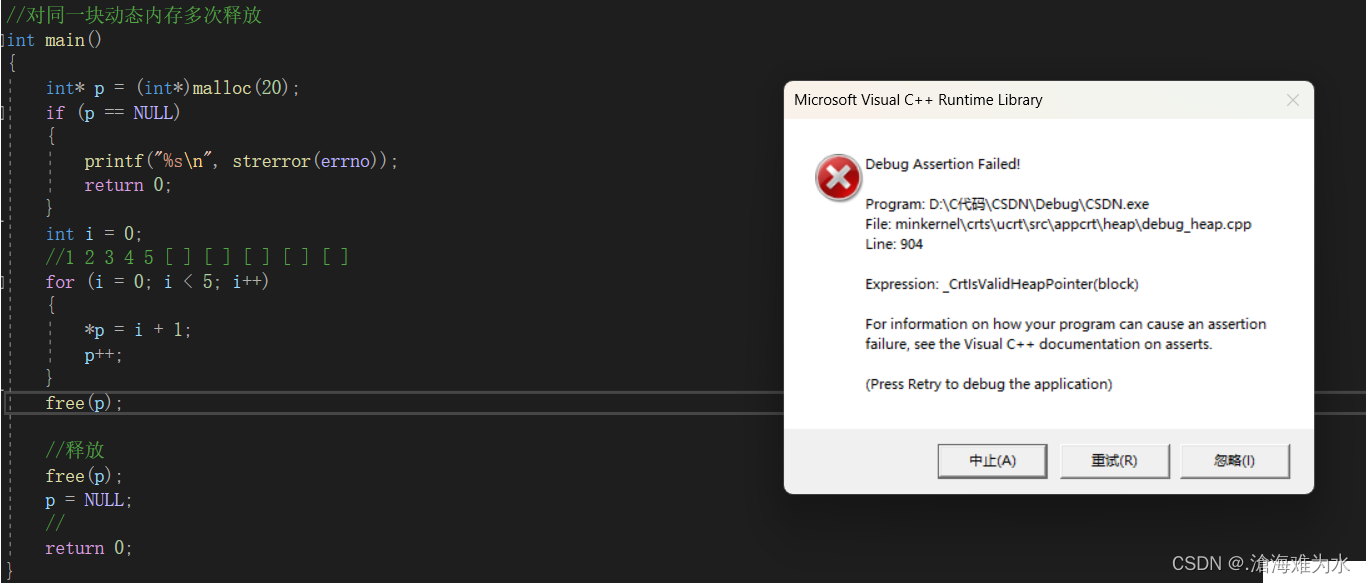
动态开辟内存忘记释放(内存泄漏)
使用 malloc、calloc、realloc 函数申请的空间,如果不想使用,需要 free 释放,如果不使用 free 释放,在程序结束后,也会由操作系统进行回收。
如果没有使用 free 释放,程序也不结束,所申请的空间既没有使用,也没有释放,也没有回收,我们将这种情况称为内存泄漏。
解决方法是:自己申请的,自己释放。自己不方便释放的,告诉别人进行释放。
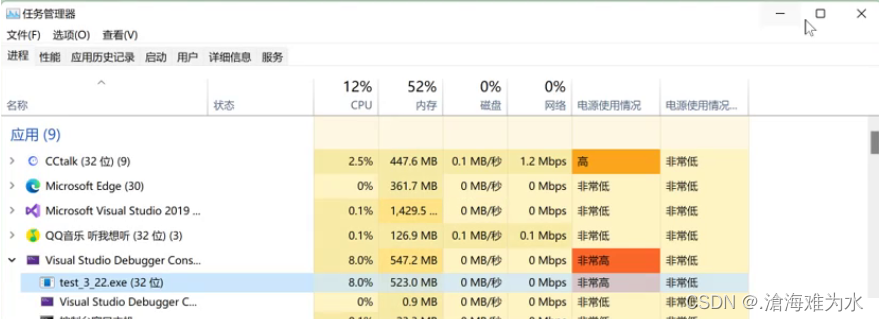
几个经典的笔试题
题目1:请问运行Test 函数有哪些的错误?
#define _CRT_SECURE_NO_WARNINGS
#include <stdio.h>
#include<stdlib.h>
#include<string.h>
void GetMemory(char* p)
{
p = (char*)malloc(100);
}
int main()
{
char* str = NULL;
GetMemory(str);
strcpy(str, "hello world");
printf(str);
return 0;
}
错误处:
- 调用 GetMemory 函数的时候,str 的传参为值传递,p 是 str 的临时拷贝,所以在GetMemory 函数内部将动态开辟空间的地址存放在 p 中的时候,不会影响 str 。所以 GetMemory 函数返回之后,str 中依然是 NULL 指针。strcpy 函数就会调用失败,原因是对 NULL 的解引用操作,程序会崩溃。
- GetMemory 函数内容 malloc 申请的空间没有机会释放,造成了内存泄漏。
解决方案一:
#define _CRT_SECURE_NO_WARNINGS
#include <stdio.h>
#include<stdlib.h>
#include<string.h>
char* GetMemory( )
{
char* p = (char*)malloc(100);
return p;
}
int main()
{
char* str = NULL;
str = GetMemory( );
strcpy(str, "hello world");
printf(str);
free(str);
str = NULL;
return 0;
}
解决方案二:
void GetMemory(char** p)
{
*p = (char*)malloc(100);
}
int main()
{
char* str = NULL;
GetMemory(&str);
strcpy(str, "hello world");
printf(str);
free(str);
str = NULL;
return 0;
}

题目2:请问运行Test 函数有哪些的错误?
#define _CRT_SECURE_NO_WARNINGS
#include <stdio.h>
#include<stdlib.h>
#include<string.h>
char* GetMemory(void)
{
char p[] = "hello world";
return p;
}
int main()
{
char* str = NULL;
str = GetMemory();
printf(str);
}
错误处:返回栈空间地址的问题
- GetMemory 函数内部有创建的数组是临时的,虽然返回了数组的起始地址给了 str ,但是数组的内存出了 GetMemory 函数就被回收了,而 str 依然保存着数组的起始地址,这时如果使用 str ,str 就是野指针。
解决方案:
#define _CRT_SECURE_NO_WARNINGS
#include <stdio.h>
#include<stdlib.h>
#include<string.h>
char* GetMemory()
{
static char p[] = "hello world";
return p;
}
int main()
{
char* str = NULL;
str = GetMemory();
printf(str);
}

题目3:请问运行Test 函数有哪些的错误?
#define _CRT_SECURE_NO_WARNINGS
#include <stdio.h>
#include<stdlib.h>
#include<string.h>
void GetMemory(char** p, int num)
{
*p = (char*)malloc(num);
}
void Test(void)
{
char* str = NULL;
GetMemory(&str, 100);
strcpy(str, "hello");
printf(str);
}
int main()
{
Test();
return 0;
}
错误处:内存泄漏
解决方案:
#define _CRT_SECURE_NO_WARNINGS
#include <stdio.h>
#include<stdlib.h>
#include<string.h>
void GetMemory(char** p, int num)
{
*p = (char*)malloc(num);
}
void Test(void)
{
char* str = NULL;
GetMemory(&str, 100);
strcpy(str, "hello");
printf(str);
free(str);
str = NULL;
}
int main()
{
Test();
return 0;
}

题目4:请问运行Test 函数有哪些的错误?
#define _CRT_SECURE_NO_WARNINGS
#include <stdio.h>
#include<stdlib.h>
#include<string.h>
void Test(void)
{
char* str = (char*)malloc(100);
strcpy(str, "hello");
free(str);
if (str != NULL)
{
strcpy(str, "world");
printf(str);
}
}
int main()
{
Test();
return 0;
}
错误处:栈空间的非法访问
解决方案:
#define _CRT_SECURE_NO_WARNINGS
#include <stdio.h>
#include<stdlib.h>
#include<string.h>
void Test(void)
{
char* str = (char*)malloc(100);
strcpy(str, "hello");
free(str);
str = NULL;
if (str != NULL)
{
strcpy(str, "world");
printf(str);
}
}
int main()
{
Test();
return 0;
}

C/C++程序的内存开辟
C/C++程序内存分配的几个区域:
- 栈区(stack):在执行函数时,函数内局部变量的存储单元都可以在栈上创建,函数执行结束时这些存储单元自动被释放。栈内存分配运算内置于处理器的指令集中,效率很高,但是 分配的内存容量有限。栈区主要存放运行函数而分配的局部变量、函数参数、返回数据、返 回地址等。
- 堆区(heap):一般由程序员分配释放,若程序员不释放,程序结束时可能由OS回收 。分 配方式类似于链表。
- 数据段(静态区)(static)存放全局变量、静态数据。程序结束后由系统释放。
- 代码段:存放函数体(类成员函数和全局函数)的二进制代码。
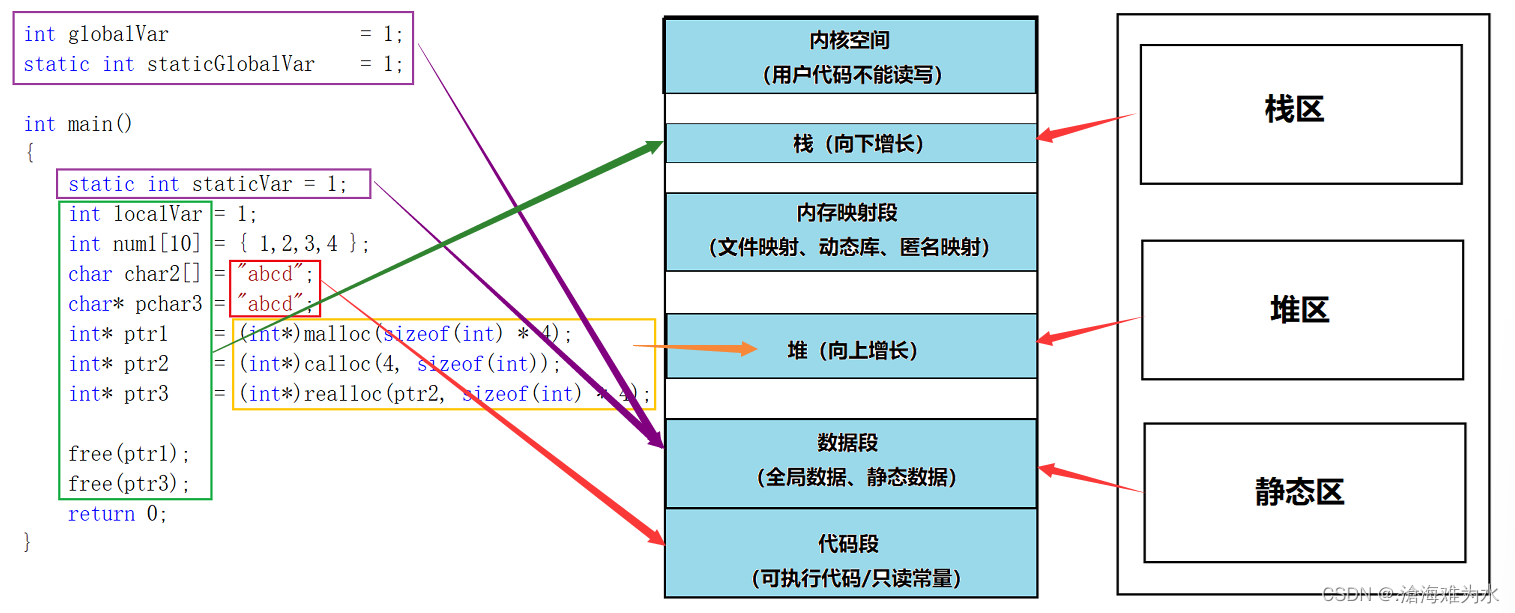
有了这幅图,我们就可以更好的理解static关键字修饰局部变量的例子了:实际上普通的局部变量是在栈区分配空间的,栈区的特点是在上面创建的变量出了作用域就销毁。但是被static修饰的变量存放在数据段(静态区),数据段的特点是在上面创建的变量,直到程序结束才销毁所以生命周期变长。
柔性数组
也许你从来没有听说过柔性数组(flexible array)这个概念,但是它确实是存在的。C99 中,结构中的最后一个元素允许是未知大小的数组,这就叫做『柔性数组』成员。
举例说明:
struct S
{
int a;
char c;
int arr[]; //int arr[0]
};
柔性数组的特点和使用
- 结构中的柔性数组成员前面必须至少一个其他成员。
- sizeof 返回的这种结构大小不包括柔性数组的内存。
- 包含柔性数组成员的结构用malloc ()函数进行内存的动态分配,并且分配的内存应该大于结构的大小,以适应柔性数组的预期大小。
#define _CRT_SECURE_NO_WARNINGS
#include <stdio.h>
#include<stdlib.h>
#include<string.h>
struct S
{
int a;
char c;
int arr[]; //int arr[0]
};
int main()
{
printf("%d\n", sizeof(struct S));
struct S* ps = (struct S*)malloc(sizeof(struct S) + sizeof(int) * 10);
if (ps == NULL)
{
printf("%s\n", strerror(errno));
return 0;
}
int i = 0;
for (i = 0; i < 10; i++)
{
ps->arr[i] = i + 1;
}
for (i = 0; i < 10; i++)
{
printf("%d ", ps->arr[i]);
}
//调整数组arr大小
struct S* ptr = (struct S*)realloc(ps, sizeof(struct S) + sizeof(int) * 20);
if (ptr == NULL)
{
printf("%s\n", strerror(errno));
return 0;
}
else
{
ps = ptr;
}
//使用
//……
free(ps);
ps = NULL;
return 0;
}

柔性数组的优势
使用结构体指针来进行模拟实现:
#define _CRT_SECURE_NO_WARNINGS
#include <stdio.h>
#include<stdlib.h>
#include<string.h>
struct S
{
int a;
char c;
int* arr;
};
int main()
{
struct S* ps = (struct S*)malloc(sizeof(struct S));
if (ps == NULL)
{
perror("malloc\n");
return 0;
}
int* ptr = (int*)malloc(sizeof(int)*10);
if (ptr == NULL)
{
perror("malloc2\n");
return 0;
}
else
{
ps->arr = ptr;
}
//使用
int i = 0;
for (i = 0; i < 10; i++)
{
ps->arr[i] = i + 1;
}
//打印
for (i = 0; i < 10; i++)
{
printf("%d ", ps->arr[i]);
}
/*对arr进行扩容*/
ptr = (int*)realloc(ps->arr,sizeof(int) * 20);
if (ptr == NULL)
{
perror("realloc\n");
return 0;
}
else
{
ps->arr = ptr;
}
free(ptr);
ptr = NULL;
free(ps);
ps = NULL;
return 0;
}
使用柔性数组和结构体指针都可以完成同样的功能,两者之间的对比:
- 柔性数组好处是:方便内存释放
malloc 一次,free 一次,容易维护空间,不容易出错。内存碎片就会减少,内存利用率就较高一些。
- 结构体指针好处是:有利于访问速度
连续的内存有益于提高访问速度,也有益于减少内存碎片。但是 malloc 两次,free 两次,维护难度加大,容易出错。内存碎片就会增多,内存利用率就下降了。
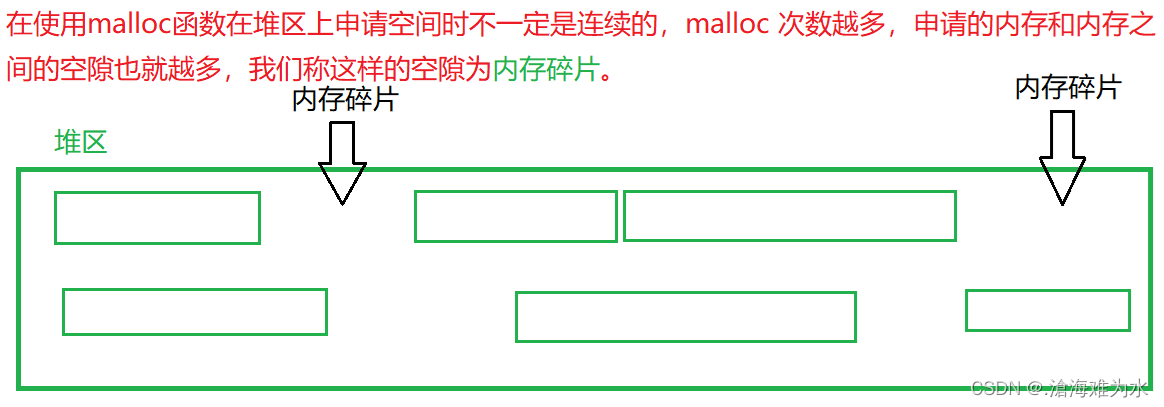
由于内存碎片比较小,在日后被利用的可能性就比较小。

本文来自互联网用户投稿,该文观点仅代表作者本人,不代表本站立场。本站仅提供信息存储空间服务,不拥有所有权,不承担相关法律责任。 如若内容造成侵权/违法违规/事实不符,请联系我的编程经验分享网邮箱:chenni525@qq.com进行投诉反馈,一经查实,立即删除!